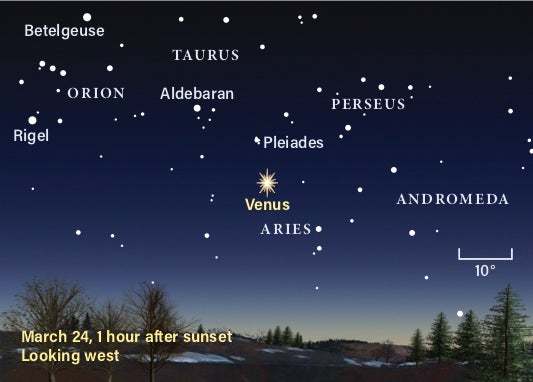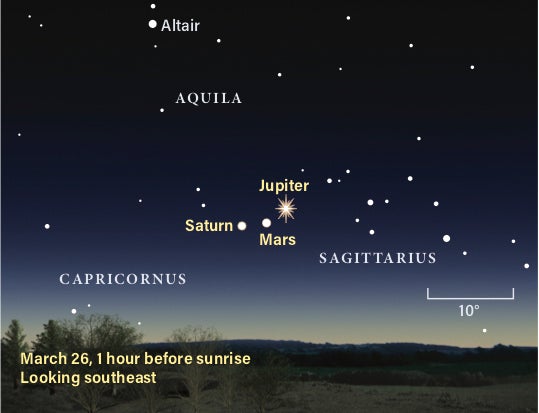It’s officially spring in the Northern Hemisphere. To celebrate, Mars and Jupiter meet up in the morning sky in the first of two planetary conjunctions this month. Look for the glittering stars of Sagittarius the Archer in the southeast in the two hours or so before sunrise. There, magnitude 0.9 Mars is a mere 0.7° south of magnitude –2.1 Jupiter.
About 7° east of Jupiter, magnitude 0.7 Saturn waits its turn for a close-up with the Red Planet. Mars will soon tango with the ringed world, coming closest on March 31.
Saturday, March 21
Today is the perfect day to seek out our solar system’s speediest planet. The Moon passes 4° south of Mercury at 2 P.M. EDT, but you’ll want to catch the pair in the morning before sunrise. At that time, the two will stand 5° apart, with Mercury glowing at magnitude 0.2 in the east-southeast 30 minutes before the Sun crosses the horizon.
Saturday is also Galactic Tick Day. The holiday is celebrated every 633.7 days (1.7361 years) to mark one “galactic tick,” which represents 1/100 of an arcsecond’s worth of the orbit our Sun and solar system make around the Milky Way. (It takes 225 million years to complete a full orbit.) You can learn more about the origins of this quirky and humbling holiday on the Galactic Tick Day homepage.
In honor of our journey through the galaxy, step outside from a dark site to see if you can spot the Milky Way running overhead. The plane of our galaxy runs through Cygnus the Swan, setting in the northwest as the sky grows darker after sunset. In the east, Orion the Hunter rises with the Milky Way at his right shoulder, which is marked by the bright red star Betelgeuse.
Sunday, March 22
The fast-fading Moon is just 3 percent lit and rises shortly before the Sun, making tonight an excellent night to search out some of the sky’s fainter objects. Consider trying for M81 and M82, also known as Bode’s Galaxy and the Cigar Galaxy, respectively. Both in the constellation of Ursa Major, these two galaxies appear only 37′ apart on the sky and are easy to catch in the same field of view through binoculars or a telescope at low magnification. M81 has an active supermassive black hole in its center, while M82 is undergoing a massive burst of star formation — hence its classification as a starburst galaxy. Astronomers believe this flurry of activity was actually caused by gravitational interactions with M81. Through a scope, M82 appears long and thin — like a cigar — while M81 has a rounder shape.
Monday, March 23
Mercury reaches greatest western elongation (28°) at 10 P.M. EDT, several hours before it rises ahead of the Sun. At sunrise, the tiny magnitude 0.3 planet is 10° above the horizon in the east-southeast, and its 7″-wide disk is just over half lit.
Today also marks the 180th anniversary of the first photograph ever taken of the Full Moon. John Draper captured the daguerreotype on this date from his observatory in New York after several previous attempts.
New Moon occurs at 5:28 A.M. EDT. A few hours later, at 11:23 A.M. EDT, the Moon also reaches apogee. This is the farthest point from Earth in its orbit, when our satellite will sit 252,707 miles (406,692 kilometers) from Earth.
Venus reaches greatest eastern elongation (46°) at 6 P.M. EDT. As the Sun sinks below the horizon, the planet will sit highest in the sky, about 43°. An hour later, Venus still shines 32° high and lies just 9° below the easy-to-spot Pleiades (M45).
Wednesday, March 25
Today marks the 365th anniversary of Christiaan Huygens’ discovery of Saturn’s largest moon, Titan. To this day, Titan is the only other solar system moon that humanity has sent a robotic probe to explore.
Saturn creeps upward in the sky before sunrise, when it will become lost in the rays of our bright home star. Before the sky begins to brighten, turn your telescope to the ringed world and try to spot the brightest moon sitting about 6″ northwest of the planet, standing alone while most of the smaller, fainter moons cluster closer to the rings.
The 26th offers planetary observers a veritable feast of sights. Early risers are rewarded with a planetary trio in the southeast an hour before sunrise: There, ruddy Mars sits midway between Jupiter and Saturn. The configuration is the closest these three worlds have come in the sky in two decades.
In the late afternoon, the thin crescent Moon passes 4° south of Uranus at 5 P.M. EDT.
Evening observers can step outside at sunset with a small scope to see that Venus’ disk is half lit. You can find the planet in the constellation of Aries the Ram, shining brightly at magnitude –4.4 at sunset. As darkness falls, scan your scope about 18° below Venus toward the horizon to find the distant planet Uranus. A 6-percent-lit Moon hovers nearby, but the ice giant’s 6th-magnitude glow should still be discernible.
Friday, March 27
Sirius, also called the Dog Star, is the brightest star in the Northern Hemisphere’s sky. Its blue-white, –1.4-magnitude glow should be easy to spot in the south as the Sun sets. Sirius A, the star we see easily from Earth, is about twice the mass of the Sun and about 1.7 times as wide. And hidden within its glow is a second, smaller star, called the Pup. This companion, named Sirius B, is a white dwarf smaller than Earth, with the mass of the entire Sun packed into its tiny frame.
Sirius B orbits its larger primary roughly once every 50 years. The two are currently more than 10″ apart — a distance that larger amateur instruments at high magnification under excellent atmospheric conditions can discern. The tiny white dwarf is 10 magnitudes fainter than Sirius A, but with patience, luck, and the right tools, you may glimpse the Pup roughly east-northeast of the brighter star.

Our exclusive Sky Guide 2020 is now available! This free downloadable pamphlet contains a month-by-month rundown of 2020’s biggest celestial events, from Mars’ best opposition in years to the return of totality in South America this December. Check out Astronomy’s Sky Guide 2020 now!












